Group Work Assignment: Social Exchange, Learning Theories Comparison
VerifiedAdded on 2022/11/09
|7
|1608
|58
Report
AI Summary
This report provides a comprehensive comparison of social exchange theory and learning theory, focusing on their application within group work contexts. It begins with an introduction to group dynamics and the importance of group work in educational settings. The report then delves into the specifics of social exchange theory, examining its core elements such as rewards, costs, and the concept of equity, alongside learning theory, which explores classical, operant, and observational learning. The similarities between the two theories are highlighted, including the role of observation, reward, and punishment. The report further differentiates the two theories by contrasting their perspectives on cost-benefit analysis and the impact of deprivation on behavior. The conclusion emphasizes the value of understanding these theories to enhance group work effectiveness, referencing the theories' distinct approaches to learning and interaction. The report is a valuable resource for students studying group dynamics, theories, and community services, and it is available on Desklib, a platform offering resources for students.

Running head: GROUP WORK 1
Group Work
Name
Institution
Group Work
Name
Institution
Paraphrase This Document
Need a fresh take? Get an instant paraphrase of this document with our AI Paraphraser
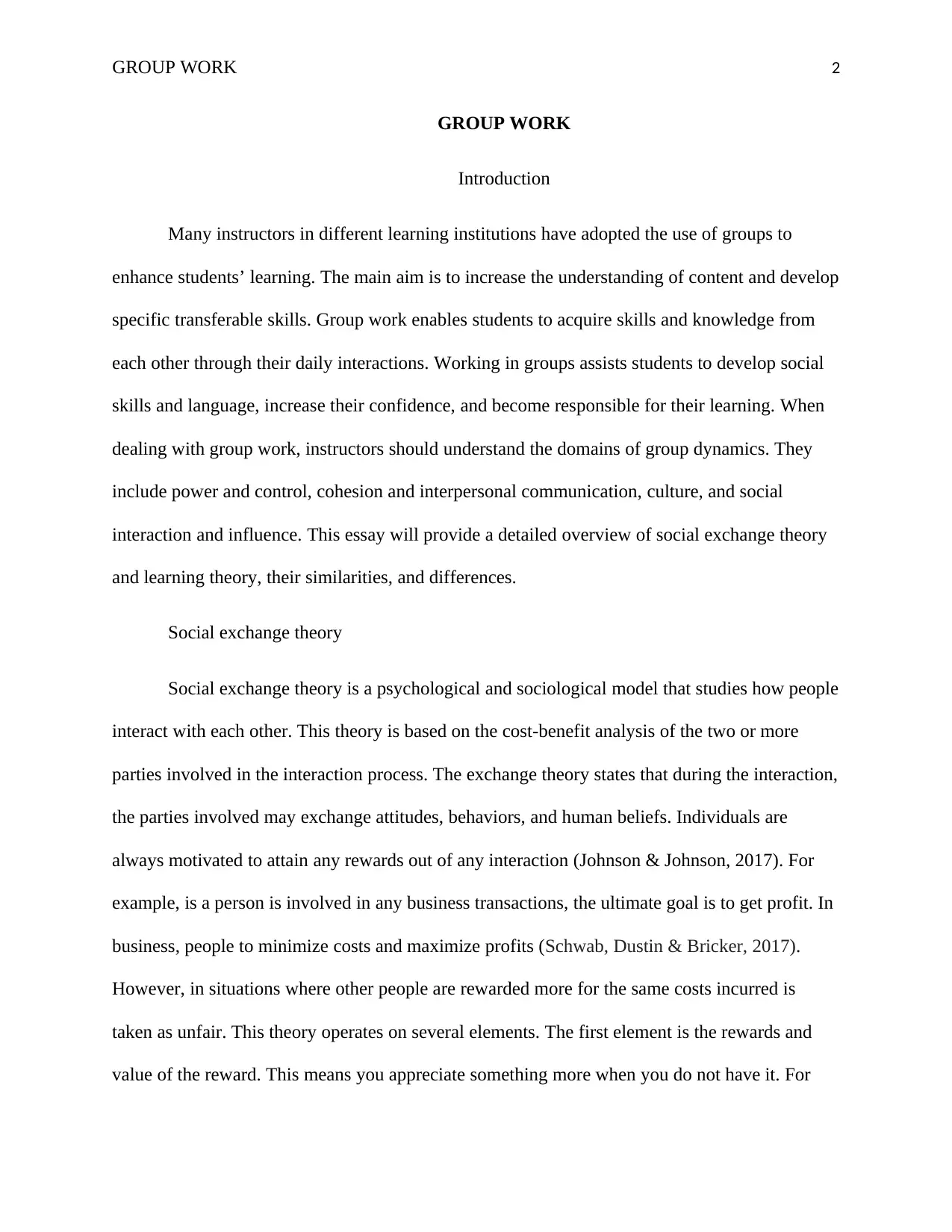
GROUP WORK 2
GROUP WORK
Introduction
Many instructors in different learning institutions have adopted the use of groups to
enhance students’ learning. The main aim is to increase the understanding of content and develop
specific transferable skills. Group work enables students to acquire skills and knowledge from
each other through their daily interactions. Working in groups assists students to develop social
skills and language, increase their confidence, and become responsible for their learning. When
dealing with group work, instructors should understand the domains of group dynamics. They
include power and control, cohesion and interpersonal communication, culture, and social
interaction and influence. This essay will provide a detailed overview of social exchange theory
and learning theory, their similarities, and differences.
Social exchange theory
Social exchange theory is a psychological and sociological model that studies how people
interact with each other. This theory is based on the cost-benefit analysis of the two or more
parties involved in the interaction process. The exchange theory states that during the interaction,
the parties involved may exchange attitudes, behaviors, and human beliefs. Individuals are
always motivated to attain any rewards out of any interaction (Johnson & Johnson, 2017). For
example, is a person is involved in any business transactions, the ultimate goal is to get profit. In
business, people to minimize costs and maximize profits (Schwab, Dustin & Bricker, 2017).
However, in situations where other people are rewarded more for the same costs incurred is
taken as unfair. This theory operates on several elements. The first element is the rewards and
value of the reward. This means you appreciate something more when you do not have it. For
GROUP WORK
Introduction
Many instructors in different learning institutions have adopted the use of groups to
enhance students’ learning. The main aim is to increase the understanding of content and develop
specific transferable skills. Group work enables students to acquire skills and knowledge from
each other through their daily interactions. Working in groups assists students to develop social
skills and language, increase their confidence, and become responsible for their learning. When
dealing with group work, instructors should understand the domains of group dynamics. They
include power and control, cohesion and interpersonal communication, culture, and social
interaction and influence. This essay will provide a detailed overview of social exchange theory
and learning theory, their similarities, and differences.
Social exchange theory
Social exchange theory is a psychological and sociological model that studies how people
interact with each other. This theory is based on the cost-benefit analysis of the two or more
parties involved in the interaction process. The exchange theory states that during the interaction,
the parties involved may exchange attitudes, behaviors, and human beliefs. Individuals are
always motivated to attain any rewards out of any interaction (Johnson & Johnson, 2017). For
example, is a person is involved in any business transactions, the ultimate goal is to get profit. In
business, people to minimize costs and maximize profits (Schwab, Dustin & Bricker, 2017).
However, in situations where other people are rewarded more for the same costs incurred is
taken as unfair. This theory operates on several elements. The first element is the rewards and
value of the reward. This means you appreciate something more when you do not have it. For
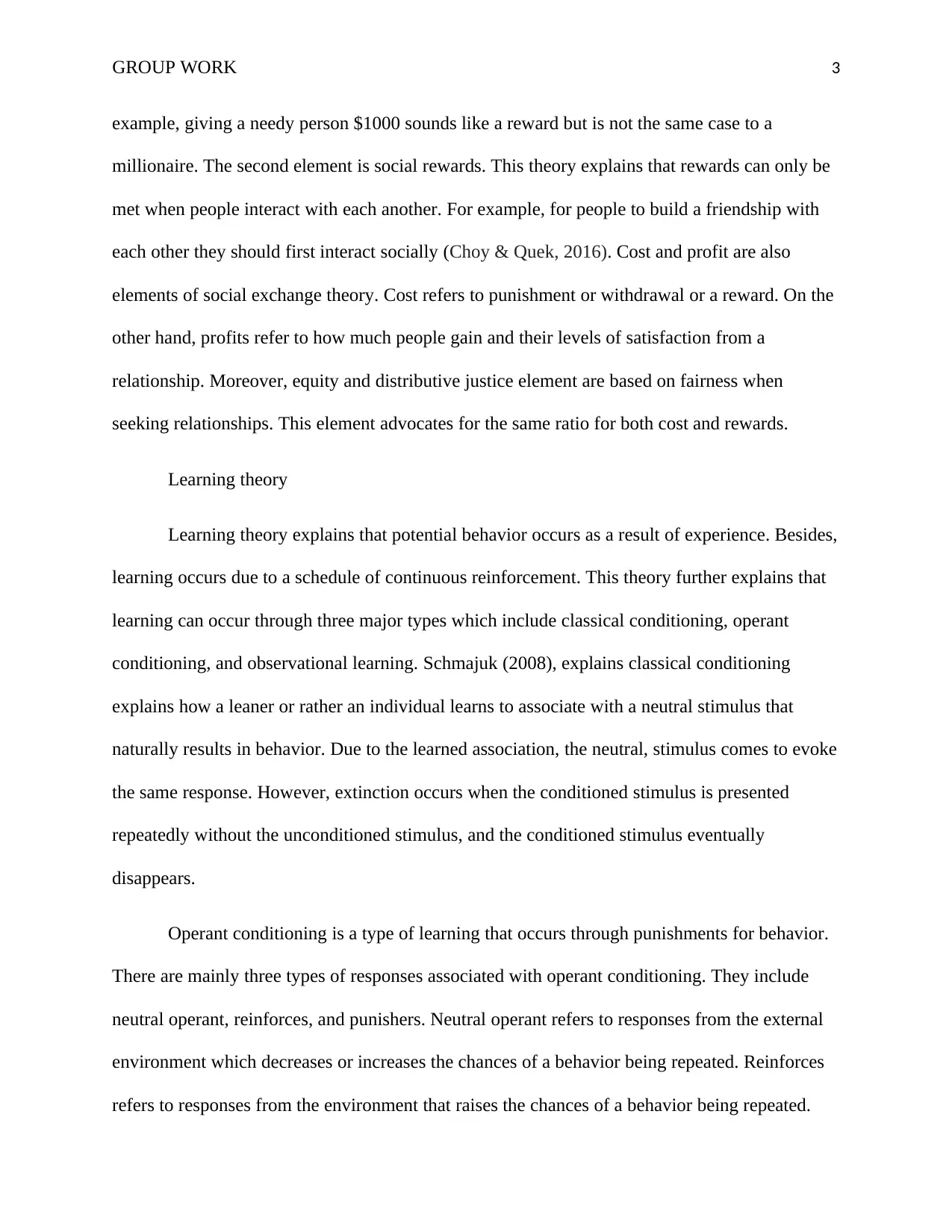
GROUP WORK 3
example, giving a needy person $1000 sounds like a reward but is not the same case to a
millionaire. The second element is social rewards. This theory explains that rewards can only be
met when people interact with each another. For example, for people to build a friendship with
each other they should first interact socially (Choy & Quek, 2016). Cost and profit are also
elements of social exchange theory. Cost refers to punishment or withdrawal or a reward. On the
other hand, profits refer to how much people gain and their levels of satisfaction from a
relationship. Moreover, equity and distributive justice element are based on fairness when
seeking relationships. This element advocates for the same ratio for both cost and rewards.
Learning theory
Learning theory explains that potential behavior occurs as a result of experience. Besides,
learning occurs due to a schedule of continuous reinforcement. This theory further explains that
learning can occur through three major types which include classical conditioning, operant
conditioning, and observational learning. Schmajuk (2008), explains classical conditioning
explains how a leaner or rather an individual learns to associate with a neutral stimulus that
naturally results in behavior. Due to the learned association, the neutral, stimulus comes to evoke
the same response. However, extinction occurs when the conditioned stimulus is presented
repeatedly without the unconditioned stimulus, and the conditioned stimulus eventually
disappears.
Operant conditioning is a type of learning that occurs through punishments for behavior.
There are mainly three types of responses associated with operant conditioning. They include
neutral operant, reinforces, and punishers. Neutral operant refers to responses from the external
environment which decreases or increases the chances of a behavior being repeated. Reinforces
refers to responses from the environment that raises the chances of a behavior being repeated.
example, giving a needy person $1000 sounds like a reward but is not the same case to a
millionaire. The second element is social rewards. This theory explains that rewards can only be
met when people interact with each another. For example, for people to build a friendship with
each other they should first interact socially (Choy & Quek, 2016). Cost and profit are also
elements of social exchange theory. Cost refers to punishment or withdrawal or a reward. On the
other hand, profits refer to how much people gain and their levels of satisfaction from a
relationship. Moreover, equity and distributive justice element are based on fairness when
seeking relationships. This element advocates for the same ratio for both cost and rewards.
Learning theory
Learning theory explains that potential behavior occurs as a result of experience. Besides,
learning occurs due to a schedule of continuous reinforcement. This theory further explains that
learning can occur through three major types which include classical conditioning, operant
conditioning, and observational learning. Schmajuk (2008), explains classical conditioning
explains how a leaner or rather an individual learns to associate with a neutral stimulus that
naturally results in behavior. Due to the learned association, the neutral, stimulus comes to evoke
the same response. However, extinction occurs when the conditioned stimulus is presented
repeatedly without the unconditioned stimulus, and the conditioned stimulus eventually
disappears.
Operant conditioning is a type of learning that occurs through punishments for behavior.
There are mainly three types of responses associated with operant conditioning. They include
neutral operant, reinforces, and punishers. Neutral operant refers to responses from the external
environment which decreases or increases the chances of a behavior being repeated. Reinforces
refers to responses from the environment that raises the chances of a behavior being repeated.
⊘ This is a preview!⊘
Do you want full access?
Subscribe today to unlock all pages.

Trusted by 1+ million students worldwide
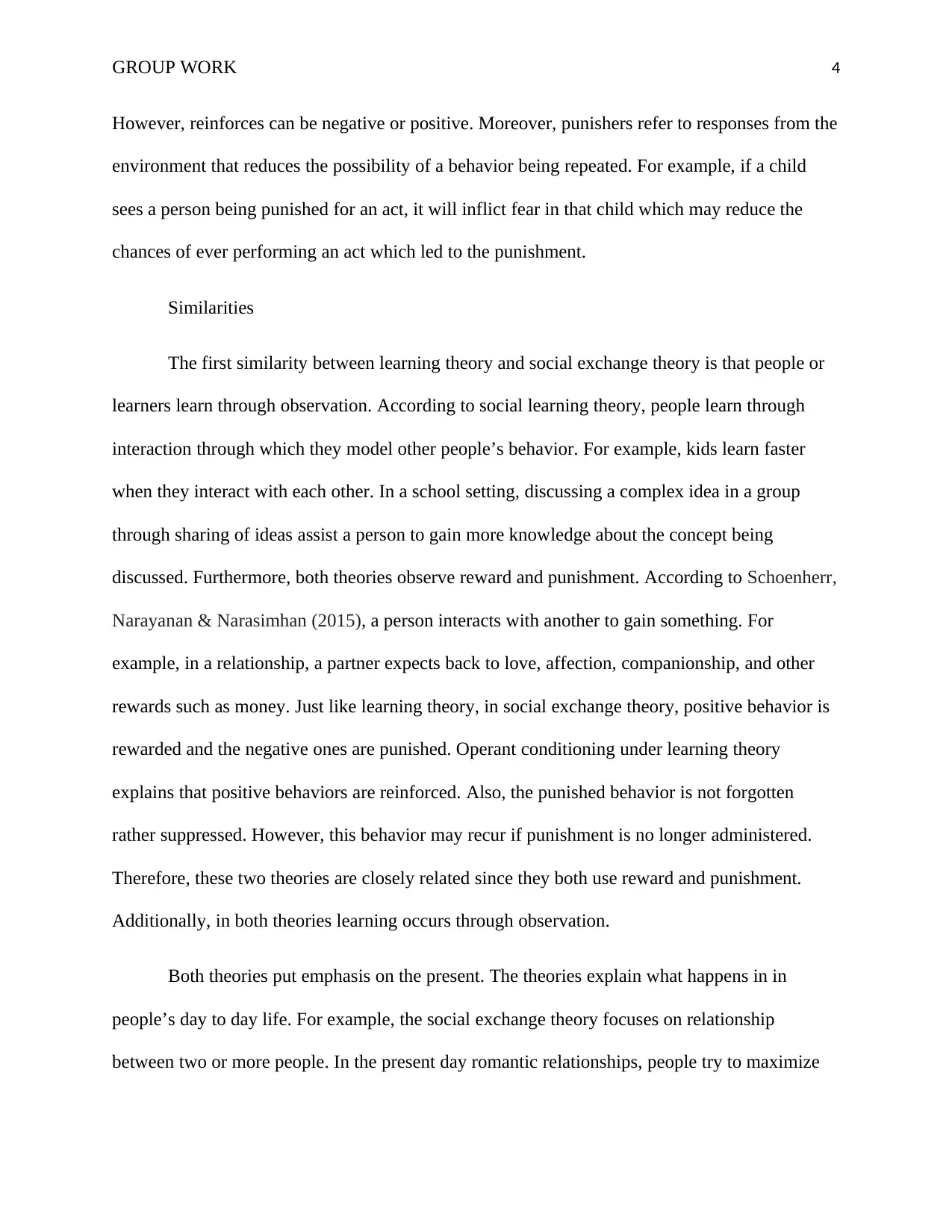
GROUP WORK 4
However, reinforces can be negative or positive. Moreover, punishers refer to responses from the
environment that reduces the possibility of a behavior being repeated. For example, if a child
sees a person being punished for an act, it will inflict fear in that child which may reduce the
chances of ever performing an act which led to the punishment.
Similarities
The first similarity between learning theory and social exchange theory is that people or
learners learn through observation. According to social learning theory, people learn through
interaction through which they model other people’s behavior. For example, kids learn faster
when they interact with each other. In a school setting, discussing a complex idea in a group
through sharing of ideas assist a person to gain more knowledge about the concept being
discussed. Furthermore, both theories observe reward and punishment. According to Schoenherr,
Narayanan & Narasimhan (2015), a person interacts with another to gain something. For
example, in a relationship, a partner expects back to love, affection, companionship, and other
rewards such as money. Just like learning theory, in social exchange theory, positive behavior is
rewarded and the negative ones are punished. Operant conditioning under learning theory
explains that positive behaviors are reinforced. Also, the punished behavior is not forgotten
rather suppressed. However, this behavior may recur if punishment is no longer administered.
Therefore, these two theories are closely related since they both use reward and punishment.
Additionally, in both theories learning occurs through observation.
Both theories put emphasis on the present. The theories explain what happens in in
people’s day to day life. For example, the social exchange theory focuses on relationship
between two or more people. In the present day romantic relationships, people try to maximize
However, reinforces can be negative or positive. Moreover, punishers refer to responses from the
environment that reduces the possibility of a behavior being repeated. For example, if a child
sees a person being punished for an act, it will inflict fear in that child which may reduce the
chances of ever performing an act which led to the punishment.
Similarities
The first similarity between learning theory and social exchange theory is that people or
learners learn through observation. According to social learning theory, people learn through
interaction through which they model other people’s behavior. For example, kids learn faster
when they interact with each other. In a school setting, discussing a complex idea in a group
through sharing of ideas assist a person to gain more knowledge about the concept being
discussed. Furthermore, both theories observe reward and punishment. According to Schoenherr,
Narayanan & Narasimhan (2015), a person interacts with another to gain something. For
example, in a relationship, a partner expects back to love, affection, companionship, and other
rewards such as money. Just like learning theory, in social exchange theory, positive behavior is
rewarded and the negative ones are punished. Operant conditioning under learning theory
explains that positive behaviors are reinforced. Also, the punished behavior is not forgotten
rather suppressed. However, this behavior may recur if punishment is no longer administered.
Therefore, these two theories are closely related since they both use reward and punishment.
Additionally, in both theories learning occurs through observation.
Both theories put emphasis on the present. The theories explain what happens in in
people’s day to day life. For example, the social exchange theory focuses on relationship
between two or more people. In the present day romantic relationships, people try to maximize
Paraphrase This Document
Need a fresh take? Get an instant paraphrase of this document with our AI Paraphraser
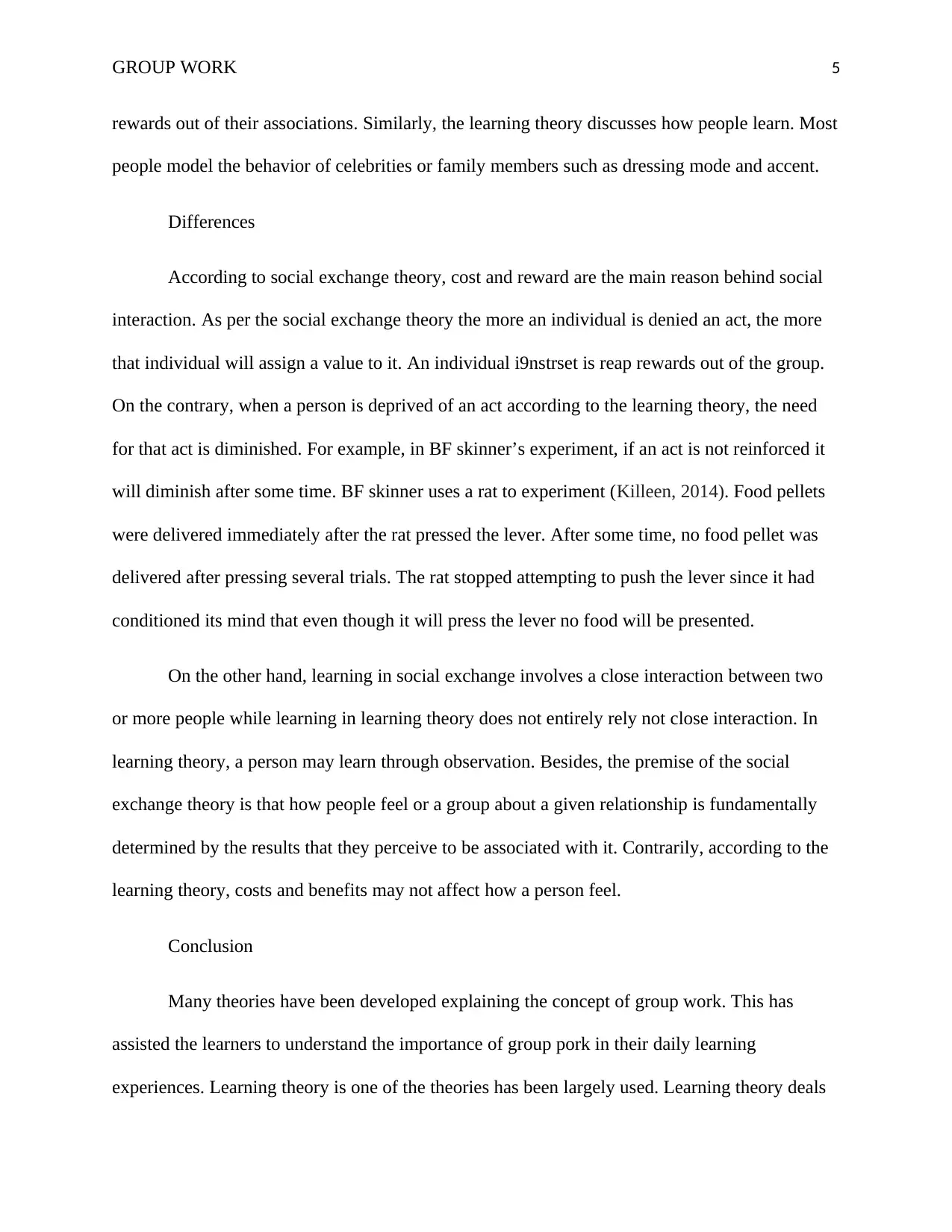
GROUP WORK 5
rewards out of their associations. Similarly, the learning theory discusses how people learn. Most
people model the behavior of celebrities or family members such as dressing mode and accent.
Differences
According to social exchange theory, cost and reward are the main reason behind social
interaction. As per the social exchange theory the more an individual is denied an act, the more
that individual will assign a value to it. An individual i9nstrset is reap rewards out of the group.
On the contrary, when a person is deprived of an act according to the learning theory, the need
for that act is diminished. For example, in BF skinner’s experiment, if an act is not reinforced it
will diminish after some time. BF skinner uses a rat to experiment (Killeen, 2014). Food pellets
were delivered immediately after the rat pressed the lever. After some time, no food pellet was
delivered after pressing several trials. The rat stopped attempting to push the lever since it had
conditioned its mind that even though it will press the lever no food will be presented.
On the other hand, learning in social exchange involves a close interaction between two
or more people while learning in learning theory does not entirely rely not close interaction. In
learning theory, a person may learn through observation. Besides, the premise of the social
exchange theory is that how people feel or a group about a given relationship is fundamentally
determined by the results that they perceive to be associated with it. Contrarily, according to the
learning theory, costs and benefits may not affect how a person feel.
Conclusion
Many theories have been developed explaining the concept of group work. This has
assisted the learners to understand the importance of group pork in their daily learning
experiences. Learning theory is one of the theories has been largely used. Learning theory deals
rewards out of their associations. Similarly, the learning theory discusses how people learn. Most
people model the behavior of celebrities or family members such as dressing mode and accent.
Differences
According to social exchange theory, cost and reward are the main reason behind social
interaction. As per the social exchange theory the more an individual is denied an act, the more
that individual will assign a value to it. An individual i9nstrset is reap rewards out of the group.
On the contrary, when a person is deprived of an act according to the learning theory, the need
for that act is diminished. For example, in BF skinner’s experiment, if an act is not reinforced it
will diminish after some time. BF skinner uses a rat to experiment (Killeen, 2014). Food pellets
were delivered immediately after the rat pressed the lever. After some time, no food pellet was
delivered after pressing several trials. The rat stopped attempting to push the lever since it had
conditioned its mind that even though it will press the lever no food will be presented.
On the other hand, learning in social exchange involves a close interaction between two
or more people while learning in learning theory does not entirely rely not close interaction. In
learning theory, a person may learn through observation. Besides, the premise of the social
exchange theory is that how people feel or a group about a given relationship is fundamentally
determined by the results that they perceive to be associated with it. Contrarily, according to the
learning theory, costs and benefits may not affect how a person feel.
Conclusion
Many theories have been developed explaining the concept of group work. This has
assisted the learners to understand the importance of group pork in their daily learning
experiences. Learning theory is one of the theories has been largely used. Learning theory deals

GROUP WORK 6
with three aspects of learning which includes classical, operant, and observational learning. This
theory is similar to social exchange theory since learning occurs through observation, reward,
and punishment. On the other hand, according to social exchanger theory, a limit in the act
makes a person to assign a value to it while a limit to an act according to learning leads to
extinction.
with three aspects of learning which includes classical, operant, and observational learning. This
theory is similar to social exchange theory since learning occurs through observation, reward,
and punishment. On the other hand, according to social exchanger theory, a limit in the act
makes a person to assign a value to it while a limit to an act according to learning leads to
extinction.
⊘ This is a preview!⊘
Do you want full access?
Subscribe today to unlock all pages.

Trusted by 1+ million students worldwide
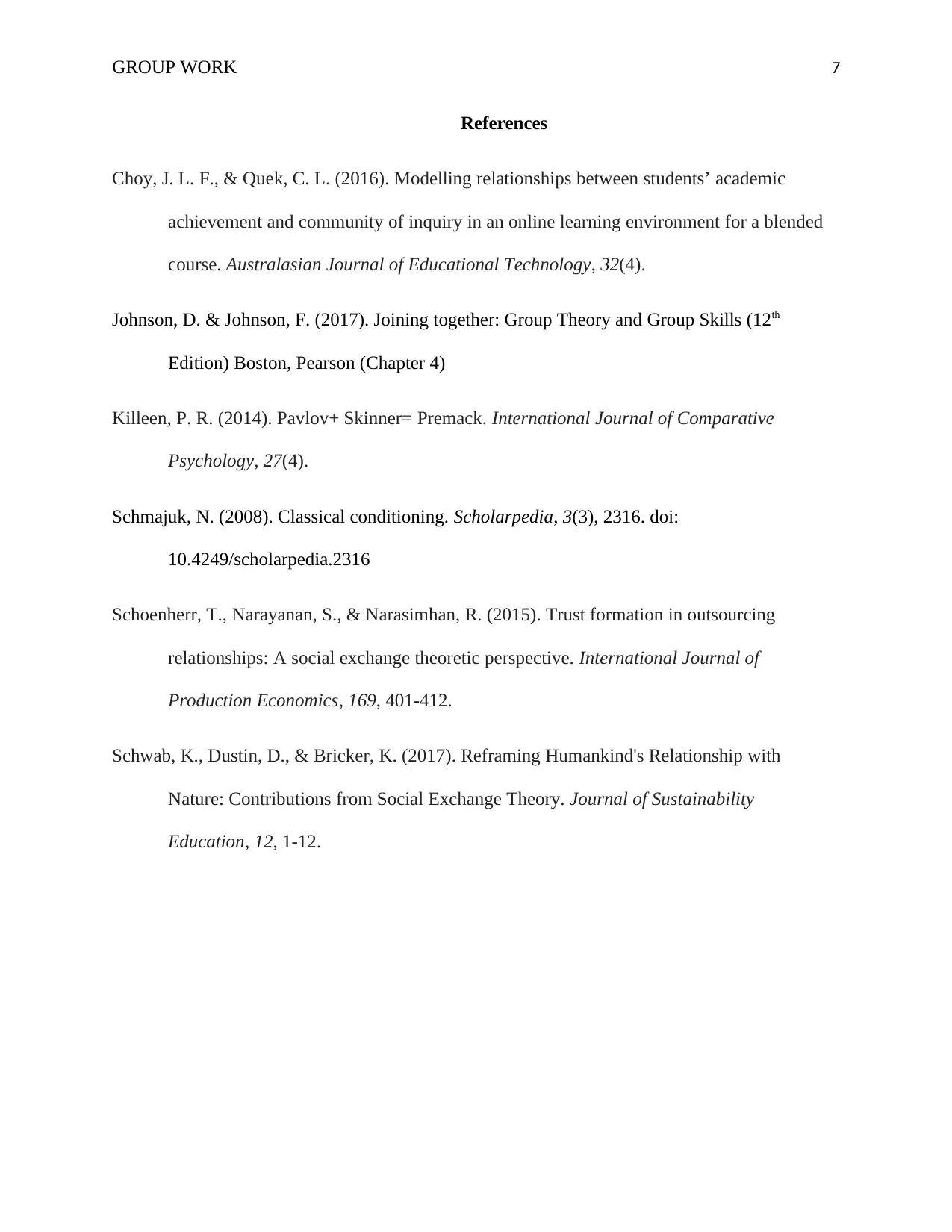
GROUP WORK 7
References
Choy, J. L. F., & Quek, C. L. (2016). Modelling relationships between students’ academic
achievement and community of inquiry in an online learning environment for a blended
course. Australasian Journal of Educational Technology, 32(4).
Johnson, D. & Johnson, F. (2017). Joining together: Group Theory and Group Skills (12th
Edition) Boston, Pearson (Chapter 4)
Killeen, P. R. (2014). Pavlov+ Skinner= Premack. International Journal of Comparative
Psychology, 27(4).
Schmajuk, N. (2008). Classical conditioning. Scholarpedia, 3(3), 2316. doi:
10.4249/scholarpedia.2316
Schoenherr, T., Narayanan, S., & Narasimhan, R. (2015). Trust formation in outsourcing
relationships: A social exchange theoretic perspective. International Journal of
Production Economics, 169, 401-412.
Schwab, K., Dustin, D., & Bricker, K. (2017). Reframing Humankind's Relationship with
Nature: Contributions from Social Exchange Theory. Journal of Sustainability
Education, 12, 1-12.
References
Choy, J. L. F., & Quek, C. L. (2016). Modelling relationships between students’ academic
achievement and community of inquiry in an online learning environment for a blended
course. Australasian Journal of Educational Technology, 32(4).
Johnson, D. & Johnson, F. (2017). Joining together: Group Theory and Group Skills (12th
Edition) Boston, Pearson (Chapter 4)
Killeen, P. R. (2014). Pavlov+ Skinner= Premack. International Journal of Comparative
Psychology, 27(4).
Schmajuk, N. (2008). Classical conditioning. Scholarpedia, 3(3), 2316. doi:
10.4249/scholarpedia.2316
Schoenherr, T., Narayanan, S., & Narasimhan, R. (2015). Trust formation in outsourcing
relationships: A social exchange theoretic perspective. International Journal of
Production Economics, 169, 401-412.
Schwab, K., Dustin, D., & Bricker, K. (2017). Reframing Humankind's Relationship with
Nature: Contributions from Social Exchange Theory. Journal of Sustainability
Education, 12, 1-12.
1 out of 7
Related Documents
Your All-in-One AI-Powered Toolkit for Academic Success.
+13062052269
info@desklib.com
Available 24*7 on WhatsApp / Email
![[object Object]](/_next/static/media/star-bottom.7253800d.svg)
Unlock your academic potential
Copyright © 2020–2025 A2Z Services. All Rights Reserved. Developed and managed by ZUCOL.





